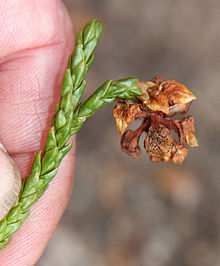– Etymology:
– Cataphyll comes from Ancient Greek κατά (kata), meaning down, and φύλλον (phyllon), meaning leaf.
– Forms:
– Cataphylls can have various forms such as spines, corm-scales, and bud-scales.
– Examples of living cataphylls include bulb-scales, rhizome-scales, cotyledons, and scaly bracts.
– Protective masses of dead leaves encircle some palm tree stems, not usually considered cataphylls.
– Cotyledons as cataphylls:
– Cotyledons are widely regarded as a class of cataphyll.
– Many cotyledons function as living tissue until the end of their function.
– Some cotyledons accumulate nutrient materials for storage and perform photosynthesis for germinating plants.
– Corm scales:
– Corm scales are the basal parts of photosynthetic leaves above ground.
– Some cormous plants produce cataphylls acting solely as tunic leaves for the corm.
– Corm tunics lack significant storage function compared to bulb-scales.
– See also:
– Leaf shape.
– Leaf size.
This article needs additional citations for verification. (January 2016) |
In plant morphology, a cataphyll (sometimes also called a cataphyllum or cataphyll leaf) is a reduced, small leaf. Many plants have both "true leaves" (euphylls), which perform most of the photosynthesis, and cataphylls, which are modified to perform other functions.

Cataphylls include bracts, bracteoles and bud scales, as well as any small leaves that resemble scales, known as scale leaves. The functions of cataphylls, such as bud scales, may be short-lived, and they are often shed after their function is fulfilled.
